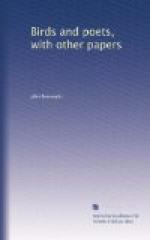In a like vein Coleridge sang:—
“’T
is the merry nightingale
That
crowds and hurries and precipitates
With
fast, thick warble his delicious notes.”
Keats’s poem on the nightingale is doubtless more in the spirit of the bird’s strain than any other. It is less a description of the song and more the song itself. Hood called the nightingale
“The sweet and plaintive Sappho of the dell.”
I mention the nightingale only to point my remarks upon its American rival, the famous mockingbird of the Southern States, which is also a nightingale,—a night-singer,—and which no doubt excels the Old World bird in the variety and compass of its powers. The two birds belong to totally distinct families, there being no American species which answers to the European nightingale, as there are that answer to the robin, the cuckoo, the blackbird, and numerous others. Philomel has the color, manners, and habits of a thrush,—our hermit thrush,—but it is not a thrush at all, but a warbler. I gather from the books that its song is protracted and full rather than melodious,—a capricious, long-continued warble, doubling and redoubling, rising and falling, issuing from the groves and the great gardens, and associated in the minds of the poets with love and moonlight and the privacy of sequestered walks. All our sympathies and attractions are with the bird, and we do not forget that Arabia and Persia are there back of its song.
Our nightingale has mainly the reputation of the caged bird, and is famed mostly for its powers of mimicry, which are truly wonderful, enabling the bird to exactly reproduce and even improve upon the notes of almost any other songster. But in a state of freedom it has a song of its own which is infinitely rich and various. It is a garrulous polyglot when it chooses to be, and there is a dash of the clown and the buffoon in its nature which too often flavors its whole performance, especially in captivity; but in its native haunts, and when its love-passion is upon it, the serious and even grand side of its character comes out. In Alabama and Florida its song may be heard all through the sultry summer night, at times low and plaintive, then full and strong. A friend of Thoreau and a careful observer, who has resided in Florida, tells me that this bird is a much more marvelous singer than it has the credit of being. He describes a habit it has of singing on the wing on moonlight nights, that would be worth going South to hear. Starting from a low bush, it mounts in the air and continues its flight apparently to an altitude of several hundred feet, remaining on the wing a number of minutes, and pouring out its song with the utmost clearness and abandon,—a slowly rising musical rocket that fills the night air with harmonious sounds. Here are both the lark and nightingale in one; and if poets were as plentiful down South as they are in New England, we should have heard of this song long ago, and had it celebrated in appropriate verse. But so far only one Southern poet, Wilde, has accredited the bird this song. This he has done in the following admirable sonnet:—




